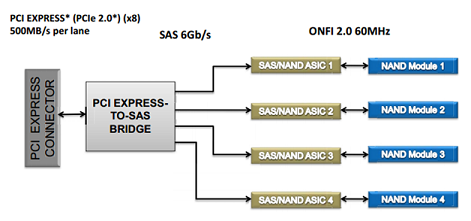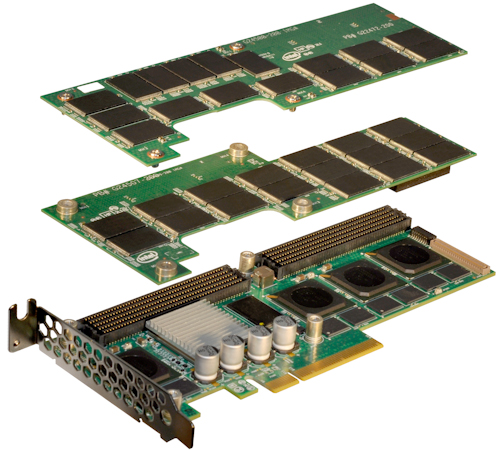Intel SSD 910 Review: PCI Express-Based Enterprise Storage
PCIe-based SSDs have evolved rapidly, with companies like Fusion-io, LSI, and OCZ leading the way. Intel is betting that its reputation for quality and reliability in the enterprise sector are enough to overcome that head-start as it launches SSD 910.
When One SSD Is Actually Four
Intel's block diagram makes clear how the SSD 910 comes together. From left to right, you have the physical PCI Express interface, the logic that facilitates communication between the PCIe bus and SAS, a multitude of SAS-based controllers, and the NAND flash itself, attached via an ONFi 2.0 interface.
In this exploded view, it's easy to see how the SSD 910 is built. Modularity is important here, as you can see from the NAND-laden daughtercards stacked on the main PCB.
That main controller board, which hosts the eight-lane, second-gen PCIe edge connector, is the brains of the operation. Under that silver heat sink, you'll find an LSISAS2008 PCIe-to-SAS controller. Armed with eight SAS 6Gb/s ports, the controller is capable of RAID 0, 1, 1E, and 10, though Intel's configuration doesn't facilitate hardware-based RAID support.
Instead, you're presented with either two or four unique volumes, depending on your version of the card. If you want to use the SSD 910 as a single, contiguous volume, it's necessary to create a software-based RAID setup.
The (positive) result is that there are no drivers to install or update. The LSISAS2008 has been on the market for quite a few years, and most modern operating systems support it natively.
LSI's PCIe-to-SAS hardware is flanked by four Intel EW29AA31AA1 controllers, pictured above, which were co-designed by Intel and Hitachi. Under them, you find DDR2 SDRAM cache chips from Micron. The controller board also hosts the interfaces used to attach the NAND daughterboards.
Each daughterboard contains 28 HET MLC NAND packages totaling 448 GB. Understandably, the second daughterboard is only utilized on the 800 GB version of Intel's drive, yielding 896 GB of flash.
Get Tom's Hardware's best news and in-depth reviews, straight to your inbox.
The SSD 910 is not a bootable device. We know that's a blow to the aspirations of hardware PC enthusiasts, but Intel makes it very clear that this is a data center-oriented product. To that end, it's understandable that you'd never want your operating system and data together on the same drive. That's not a show-stopping feature for the SSD 910's target market. But it is a unique decision from Intel, considering that many of its competitors do support this.
Current page: When One SSD Is Actually Four
Prev Page SSD 910 Gets A True Enterprise-Class Workout Next Page Default Versus Maximum Performance Mode-
that is one fast Sequential read speed. It to bad that they will be $1000+ market and out of reach of all but the server/ workstation crowdReply
-
The OCZ is tested with compressible data? talk about best case scenario. what were the incompressible results like?Reply
-
s3anister PCI-E Solid State Storage is great but I can't help but wonder; where is the Memristor? The true performance gains to be had are with massive RAM-disks that aren't volatile.Reply -
apache_lives The most important and un-comparable factor here is 5 years later those Intel SSD's will still be functional, any other brand im surprised they last 5 months in normal machines with the failure rates i have seen first hand - OCZ, GSkill etc there all horrible i bought an Intel SSD for this reason - THEY WORK.Reply
Review sites never cover real world use - that is to live with it day in day out (reliability), its not all about raw speed and performance. -
ZakTheEvil Yeah, consumer SSD reliability is a bit of disappointment. At best they seem to be as reliable as hard drives.Reply -
georgeisdead This is a note to address several articles I have come across lately that state intel's reputation for quality and reliability in the SSD market as if it is a given. These comments are from my personal experience with intel's drives. I have owned 3 intel solid state drives, one X25-M G1, and two X25-M G2's. The X25-M G1 failed after 2 years while one of the G2 drives failed after 2.5 years. Now, I am not an expert on MTBF and reliability, but in my opinion this is a pretty poor track record. It is entirely possible that this is a coinicidence, however both drives failed in the same manner, from the same problem (determined by a third party data recovery specialist): Bad NAND flash.Reply
As best I understand it as it was descibed by the company that analyzed these failed drives, a block of NAND flash either went bad or became inaccessible by the controller rendering the drives useless and unable to be accessed by normal means of hooking it up to a SATA or USB port. Two drives, different NAND (50 nm for the G1 and 34 nm for the G2), same failure mode.
Once again, this is not definitive, just my observations but to me, I think review sites need to be a little more cautious about how they qualify intel's reputation for quality and reliability because from my perspective, intel has neither and I have since began using crucial SSD's. Hopefully, I will see much longer life from these new drives. -
jdamon113 I would like to see something like this stacked in our EMC, Could this drive with a rack of othere just like it, run 24/7 for 3 + years, Sure we replace a drive here and there in our EMC, but the unit as a whole has never went down in its 5 year life.Reply
Intel, you should test these drive in that real world application. EMC, VM-ware and several data bases carve out some LUN's and Push the envelope. In this situation, should the device prove worthy, the 4000 price tag will come down very fast, and the data center will put it trust in product, So for those reading this for your personal home workstation and gaming ridge, you need not apply in this arena.
Intel is just about 18-months 2 years of owning the data center, Even EMC is powered by intel. -
jaquith Enterprise e.g. SQL you need SLC otherwise you'd be making a career replacing drives. The cost is down time and replacement. I can write more 'stuff' but it's that simple. For our IDX and similar read data it about reliability and capacity.Reply -
willard razor7104that is one fast Sequential read speed. It to bad that they will be $1000+ market and out of reach of all but the server/ workstation crowdThat's because this was not designed for consumers. It's not like they're marking the price up 1000% for shits and giggles. Enterprise hardware costs more to make because it must be much faster and much more reliable.Reply
This drive, and every other piece of enterprise hardware out there, was never meant to be used by consumers. -
drewriley jimbob rubaeThe OCZ is tested with compressible data? talk about best case scenario. what were the incompressible results like?Reply
Check out the Sequential Performance page, lists both compressible and incompressible. For all the other tests, random (incompressible) data was used.


